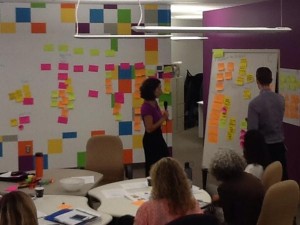In our work at Spring2 Innovation we use Design Thinking to help clients solve complex problems collaboratively and increase innovation in organizations. However, as we speak with new clients we often get questions around the differences between Design Thinking and Lean Startup. Some organizations have been using Lean and are reluctant to try a new methodology, which on the surface looks very similar to what they’re already using.
Alex Cowan from the Faculty of UVA Darden & Partner at Synapse recently provided the following definition of Design Thinking and Lean Startup:
- Design Thinking deals with using customer empathy and creativity to create valuable solutions. It deals with prototyping and ‘testing’ those prototypes, but that testing is still more about exploration and learning than it is about the kind of definitive ‘pass/fail’ you’re driving to with lean/Lean Startup.
Design Thinking was used at Proctor and Gamble to come up with new products and product lines by analyzing how consumers use products. Proctor and Gamble employees would go into consumer’s homes and observe them cleaning their homes. Bounty Select-A-Size was actually developed after employees witnessed consumers tearing and cutting paper towels into smaller pieces. Proctor and Gamble pays attention to how consumers behave to address unarticulated needs. Understanding the consumer is vital for Proctor and Gamble’s continued success.
- Lean Startup deals with structuring your ideas as hypothesis so you can test them with the scientific method, driving to a definitive ‘pass/fail’ and next decision on what to do. It also deals with creative ways you can do that to maximize your learning and minimize waste. It’s very design-friendly, but it doesn’t really deal with where those ideas come from.
Lean Startup was used at DropBox (a file sharing software company) where they developed a minimum viable product, tested it with potential users, and received feedback. The initial product’s capabilities were presented to potential users in a 3-minute video. The product pivoted based on the feedback from potential users. This process was repeated numerous times. Potential customers helped them to clarify what they should be developing by providing comments on what they liked and didn’t like. The team refined the product based on the input. This methodology also made it possible for DropBox to have a following before their product was even released. Lean Startup is about making the product better through client input.
In the opinion of Spring2, Design Thinking is useful in the initial phase of a project to get to know your customer and determine their needs or to get to truly understand a challenge. Design Thinking is also essential for complex problem solving where there are a number of challenges, clients or stakeholders in order to get to the real challenge. Empathizing with clients and understanding the problem before coming up with solutions is key.
Spring2 prefers Design Thinking when working with clients who want to innovate and do things differently because it provides an opportunity to think about the problem from various angles and perspectives. Design Thinking isn’t about testing or validating a solution, although ideas are still prototyped and tested. Design thinking is about exploring the problem further to get at unarticulated needs and create creative solutions to a well understood problem.
